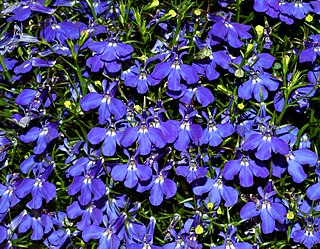
Lobelia is a genus of flowering plants in the family Campanulaceae comprising 415 species, with a subcosmopolitan distribution primarily in tropical to warm temperate regions of the world, a few species extending into cooler temperate regions. They are known generally as lobelias.

Ungnadia is a genus of flowering plants in the family Sapindaceae containing one species, Ungnadia speciosa, the Mexican buckeye. It is native to northern Mexico, as well as Texas and southern New Mexico in the United States. The name honours Austrian ambassador Baron David von Ungnad, who brought the horse chestnut to Vienna in 1576, introducing the plant into western Europe.

Livistona is a genus of palms, the botanical family Arecaceae, native to southeastern and eastern Asia, Australasia, and the Horn of Africa. They are fan palms, the leaves with an armed petiole terminating in a rounded, costapalmate fan of numerous leaflets.

Streblorrhiza was a monotypic genus of legumes in the family Fabaceae. Its only species was Streblorrhiza speciosa, a perennial shrub endemic to Phillip Island. It is now presumed extinct.
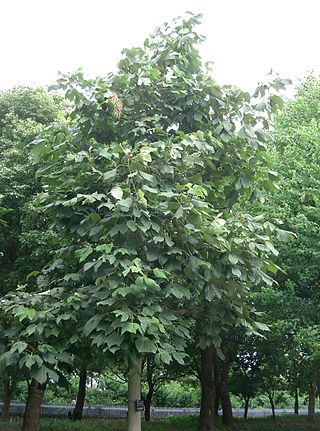
Firmiana is a genus of flowering plant in the family Malvaceae, formerly placed in the now defunct Sterculiaceae; it may sometimes be called the "parasol tree". The genus name honours Karl Joseph von Firmian.
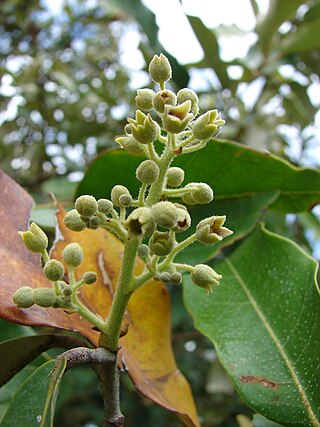
Heritiera is a genus of flowering plants in the family Malvaceae, subfamily Sterculioideae. They are most dominant tropical forest trees in several areas in eastern Africa and India to the Pacific. Some are mangroves. Several are valuable for their timber and are over-exploited.
Paranephelium is a genus of Asian small trees in family Sapindaceae, subfamily Sapindoideae.
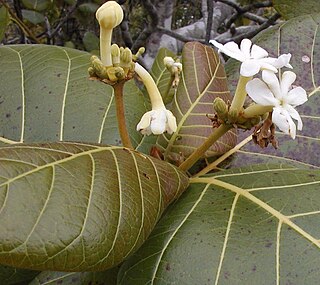
Guettarda speciosa, with common names sea randa, or zebra wood, is a species of shrub in the family Rubiaceae found in coastal habitats in tropical areas around the Pacific Ocean, including the coastline of central and northern Queensland and Northern Territory in Australia, and Pacific Islands, including Micronesia, French Polynesia and Fiji, Malaysia and Indonesia, Maldives and the east coast of Africa. It reaches 6 m in height, has fragrant white flowers, and large green prominently-veined leaves. It grows in sand above the high tide mark.

Eucyclodes is a genus of moths in the family Geometridae. According to the Catalogue of Life as of March 2017, only E. buprestaria is included in the genus. Other species are categorized into Chloromachia.

Acanthoxyla is a genus of stick insects in the family Phasmatidae. All the individuals of the genus are female and reproduce asexually by parthenogenesis. However, a male Acanthoxyla inermis was recently discovered in the UK, probably the result of chromosome loss. The genus is the result of interspecific hybridisation resulting in some triploid lineages and some diploid lineages. The genus is endemic to New Zealand, but some species have been accidentally introduced elsewhere. The genus name Acanthoxyla translates from Greek as prickly stick.
Ryania speciosa var. mutisii is an extinct plant of Colombia, a variety of Ryania speciosa.

Ryania speciosa is a species of plant in the family Salicaceae.

Austracris is a genus of Orthoptera: Caeliferan insect in the family Acrididae: subfamily Cyrtacanthacridinae. It includes an Australian pest, the spur-throated locust.
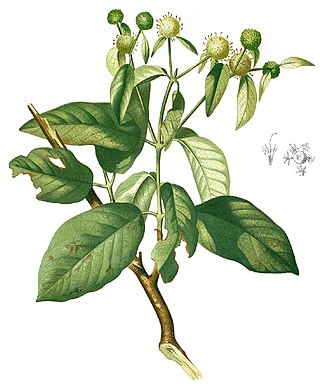
Mitragyna diversifolia is a tree species in the family Rubiaceae and found in Asia. The Catalogue of Life lists no subspecies.

Protium serratum is a small-medium tree species in the genus Protium and the family Burseraceae. The Catalogue of Life does not record any subspecies.

Rhyssella is a genus of ichneumon wasps in the family Ichneumonidae. There are about 10 described species in Rhyssella.
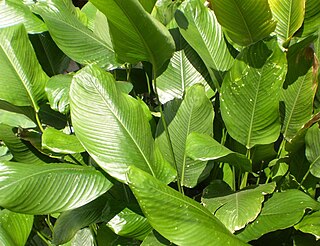
Stachyphrynium placentarium is a species of plant in the family Marantaceae. Its basionym was Phyllodes placentaria Lour. and was subsequently long placed as various species in the genus Phrynium. The species is widespread throughout Asia, with records from Bhutan, southern China, India, Indo-China and Indonesia; no subspecies are listed in the Catalogue of Life.

Phrynium pubinerve is the type species of the plant genus Phrynium, in the family Marantaceae. It is widespread throughout Asia, with records from India, China, and Indo-China through to New Guinea; no subspecies are listed in the Catalogue of Life.
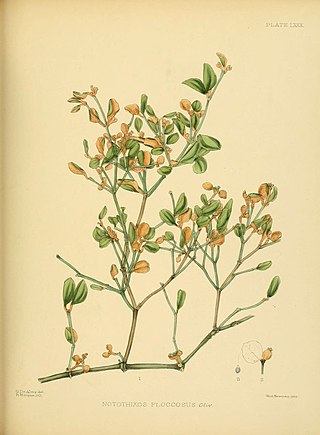
Notothixos is a genus of mistletoe plant in the family Santalaceae.

Bouea is an Asian genus of fruiting trees in the family Anacardiaceae. Species can be found in southern China, Indo-China and Malesia.


















